Law Companion Ruling
LCR 2018/D3
Consolidation: churning of joining entities by foreign-owned groups
-
Please note that the PDF version is the authorised consolidated version of this ruling and amending notices.This document has been finalised by LCR 2019/2.There is a Compendium for this document: LCR 2019/2EC .
| Table of Contents | Paragraph |
|---|---|
| What this draft Ruling is about | |
| Date of effect | |
| Where multiple entities join the consolidated group | |
| Example 1: 100% owned subsidiary | |
| Example 2: 70% owned subsidiary | |
| Associates of the control entity | |
| Example 3: associate inclusive control | |
| Relief for post-acquisition restructures within 12 months | |
| Your comments |
|
Relying on this Ruling
This Law Companion Ruling is a draft for consultation purposes only. When the final Ruling issues, it will have the following preamble: This Ruling describes how the Commissioner will apply amendments made by Part 5 of Schedule 1 to the Treasury Laws Amendment (Income Tax Consolidation Integrity) Act 2018. If you rely on this Ruling in good faith, you will not have to pay any shortfall tax or interest in respect of matters covered by the Ruling if it does not correctly state how a relevant provision applies to you. |
What this draft Ruling is about
1. This draft Ruling provides guidance on the churning measure[1] in section 716-440 of the Income Tax Assessment Act 1997 (ITAA 1997).[2]
2. All legislative references in this draft Ruling are to the ITAA 1997 unless otherwise stated.
3. The churning measure switches off the entry tax cost setting rules when a joining entity becomes a subsidiary member of a consolidated group where:
- (a)
- a foreign resident entity ceased to hold membership interests in:
- -
- the joining entity, or
- -
- a higher level entity which holds membership interests in the joining entity directly or through one or more interposed entities and which becomes a member of the consolidated group at the same time[3]
- within the period starting 12 months before the joining time and ending immediately after the joining time ('test period')
- (b)
- a capital gain or capital loss (if any) made by the foreign resident entity would be disregarded because of the operation of Division 855[4], and
- (c)
- there has been no change in the majority economic ownership of the joining entity throughout the test period.
4. The Explanatory Memorandum to the Treasury Laws Amendment (Income Tax Consolidation Integrity) Bill 2018 (the EM) contains a detailed outline of the measure in paragraphs 1.173 to 1.191.
5. This draft Ruling supplements the EM by providing:
- (a)
- practical examples on the application of subsections 716-440(4) and (5)
- (b)
- a practical example on the 'associate-inclusive' total participation interests requirements in paragraphs 716-440(1)(f) and (g), and
- (c)
- a warning on the potential application of the general anti-avoidance provisions of Part IVA of the Income Tax Assessment Act 1936 (ITAA 1936) in relation to artificial or contrived arrangements designed to exploit the 12 month test period in paragraph 716-440(1)(b).
Date of effect
6. It is proposed that when this draft Ruling issues in final form, it will generally apply in relation to an income year in respect of an entity that becomes a subsidiary member of a consolidated group or multiple entry consolidated (MEC) group under an arrangement that commences on or after 7.30pm, by legal time in the Australian Capital Territory, on 14 May 2013, unless paragraph 7 of this draft Ruling applies.
7. The extension of the control test to cover participation interests of associates, as discussed in paragraphs 22 to 29 of this draft Ruling, will only apply to an arrangement that commences on or after the start of the day on 15 February 2018.[5]
Where multiple entities join the consolidated group
8. Subsection 716-440(1) sets out the conditions to be satisfied in order for the entry tax cost setting rules, as they apply to a joining entity's assets, to be switched off under subsection 716-440(2).
9. One of these conditions requires a disposing entity to cease holding membership interests in the:
- (a)
- joining entity, or
- (b)
- a higher level entity which holds membership interests in the joining entity directly or through one or more interposed entities and which becomes a member of the consolidated group or MEC group[6] at the same time,
during the test period that starts 12 months before the joining time and ends immediately after the joining time (the 'ceasing to hold' condition).[7]
10. A membership interest means each interest or set of interests, or each right or set of rights, in relation to an entity by virtue of which another entity is a member.
11. The purpose of the 'ceasing to hold' condition applying to membership interests in a higher level entity is to ensure that the entry tax cost setting rules are switched off in respect of the assets of all joining entities with linked membership interests when multiple entities join a consolidated group or MEC group at the same time.
Example 1: 100% owned subsidiary
12. On 1 July 2017, FP Co (a foreign resident company) beneficially owns all of the membership interests in NH Co, HL Co and PHC Co respectively. HL Co, in turn, beneficially owns all of the membership interests in JE Co.
13. NH Co, HL Co, PHC Co and JE Co are all Australian resident companies. HL Co, PHC Co and JE Co are members of a MEC group. NH Co is not a member of a consolidated group or MEC group.
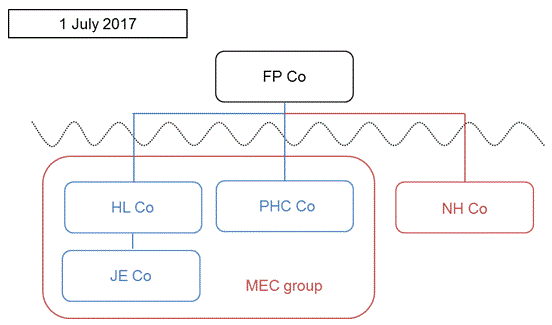
14. On 1 September 2018, FP Co disposed of all of its membership interests in HL Co to NH Co. As a result, CGT event A1 happened and FP Co makes a capital gain which is disregarded under Division 855. It is reasonable to conclude that throughout the period 1 July 2017 to 1 September 2018 there were no other changes to the beneficial ownership of membership interests in NH Co, HL Co, PHC Co and JE Co.
15. Upon NH Co becoming the beneficial owner of all of the membership interests in HL Co, NH Co makes a choice to form a consolidated group with effect from 1 September 2018 (the joining time) consisting of NH Co, HL Co and JE Co (the NH Co consolidated group) and notifies the ATO of this choice.
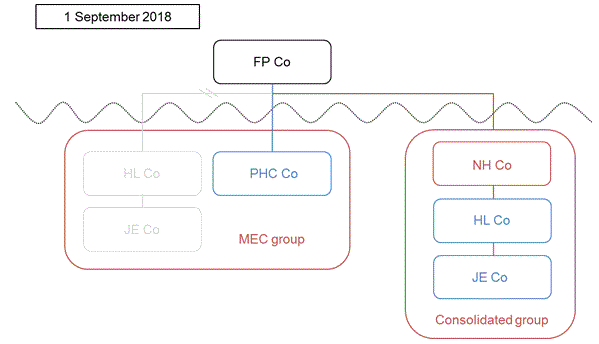
16. The conditions in subsection 716-440(1) are satisfied for both HL Co and JE Co in this example. The following analysis focuses on the application of the churning rule to JE Co:
- •
- paragraph 716-440(1)(a) is satisfied as JE Co (the joining entity) became a subsidiary member of a consolidated group (the NH Co consolidated group) at the joining time
- •
- paragraph 716-440(1)(b) is modified by subsection 716-440(5) because:
- •
- as such, subsection 716-440(5) operates to extend the condition in paragraph 716-440(1)(b) to include a reference to FP Co ceasing to hold membership interests in HL Co and, because FP Co ceased to hold the membership interests in HL Co during the period starting 12 months before the joining time and ending immediately after the joining time (the 'test period'), paragraph 716-440(1)(b) is satisfied
- •
- paragraphs 716-440(1)(c) and (d) are satisfied as CGT event A1 happened as a result of FP Co ceasing to hold membership interests in HL Co and the resulting capital gain was disregarded under Division 855
- •
- paragraph 716-440(1)(e) is satisfied because, if the churning measure did not apply, the entry tax cost setting rules would have applied to reset the tax cost of JE Co's assets at the joining time[10]
- •
- paragraph 716-440(1)(f) is satisfied as, throughout the test period, FP Co (the control entity) held total participation interests of 50% or more in JE Co
- •
- paragraph 716-440(1)(g) is not relevant in this example as FP Co is the control entity and the disposing entity.
Example 2: 70% owned subsidiary
17. On 1 May 2017, FP Co (a foreign resident company) beneficially owns all of the membership interests in NH Co, HL Co and PHC Co respectively. HL Co, in turn, owns 70% of the membership interests in JE Co. The remaining 30% of the membership interests in JE Co are owned by NH Co.
18. HL Co, PHC Co and JE Co are all Australian resident companies. HL Co and PHC Co are members of a MEC group. NH Co is a wholly owned Australian resident subsidiary of FP Co but sits outside the MEC group.
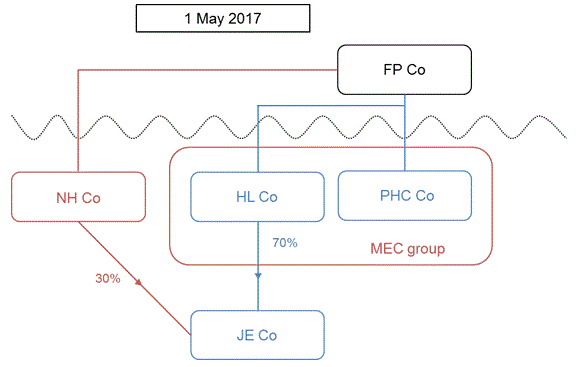
19. On 1 July 2018, FP Co disposed of all of its membership interests in HL Co to NH Co. As a result, CGT event A1 happened and FP Co makes a capital gain which is disregarded under Division 855. It is reasonable to conclude that throughout the period 1 May 2017 to 1 July 2018 there were no other changes to the beneficial ownership of membership interests in NH Co, HL Co and JE Co.
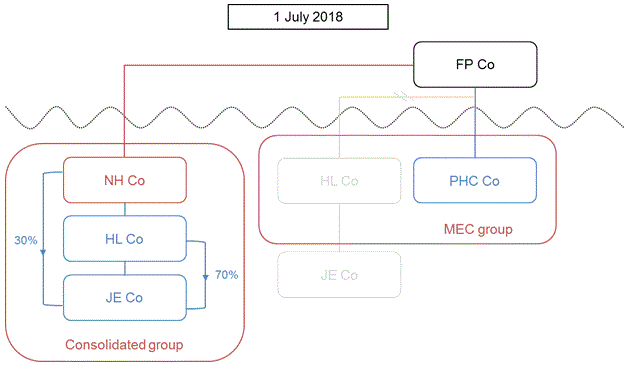
20. Upon NH Co becoming the beneficial owner of all of the membership interests in HL Co, NH Co makes a choice to form a consolidated group with effect from 1 July 2018 (the joining time) consisting of NH Co, HL Co and JE Co (the NH Co consolidated group) and notifies the ATO of this choice.
21. The conditions in subsection 716-440(1) are satisfied for both HL Co and JE Co in this example. The analysis below focuses on the application of the churning rule to JE Co:
- •
- paragraph 716-440(1)(a) is satisfied as JE Co (the joining entity) became a subsidiary member of a consolidated group (the NH Co consolidated group) at the joining time
- •
- paragraph 716-440(1)(b) is modified by subsection 716-440(5) because:
- •
- as such, subsection 716-440(5) operates to extend the condition in paragraph 716-440(1)(b) to include a reference to FP Co ceasing to hold membership interests in HL Co and, because FP Co ceased to hold the membership interests in HL Co during the period starting 12 months before the joining time and ending immediately after the joining time (the 'test period'), paragraph 716-440(1)(b) is satisfied
- •
- paragraphs 716-440(1)(c) and (d) are satisfied as CGT event A1 happened as a result of FP Co ceasing to hold membership interests in HL Co and the resulting capital gain was disregarded under Division 855
- •
- paragraph 716-440(1)(e) is satisfied because, if the churning measure did not apply, the entry tax cost setting rules would have applied to reset the tax cost of JE Co's assets at the joining time
- •
- paragraph 716-440(1)(f) is satisfied as, throughout the test period, FP Co (the control entity) maintained a total participation interest of at least 50% in JE Co
- •
- paragraph 716-440(1)(g) is not relevant in this example as FP Co (the control entity) is the disposing entity.
Associates of the control entity
22. The operation of paragraphs 716-440(1)(f) and (g) are outlined in the EM at paragraphs 1.179 to 1.181. The tests in paragraphs 716-440(1)(f) and (g) both require a total participation interest of the control entity and its associates of 50% or more in the joining entity.
23. The term 'associate' takes its meaning from section 318 of the ITAA 1936. In this context, the control entity's associates may include:
- •
- another entity[13] which exercises sufficient influence over[14], or holds a majority voting interest in[15], the control entity, and
- •
- another company that the control entity exercises sufficient influence over[16], or holds a majority voting interest in.[17]
Example 3: associate inclusive control
24. On 1 September 2018, Foreign Co 1, Foreign Co 2 and Foreign Co 3 (all foreign resident companies) beneficially own all of the membership interests in Aus Co. Aus Co is an Australian resident company.
25. The membership interests in Foreign Co 1, Foreign Co 2 and Foreign Co 3 are all owned by a foreign family.

26. On 1 October 2019, Foreign Co 1, Foreign Co 2 and Foreign Co 3 jointly incorporate an Australian resident company, New Co.
27. On 1 October 2019, Foreign Co 1, Foreign Co 2 and Foreign Co 3 dispose of the membership interests in Aus Co to New Co. CGT event A1 happens to each of Foreign Co 1, Foreign Co 2 and Foreign Co 3 and each company makes a capital gain that is disregarded under Division 855. It is reasonable to conclude that throughout the period 1 September 2018 to 1 October 2019 there were no other changes to the beneficial ownership of membership interests in Aus Co.
28. New Co makes a choice to form a consolidated group with Aus Co (the New Co consolidated group) with effect from 1 October 2019 (the joining time) and notifies the ATO of that choice.
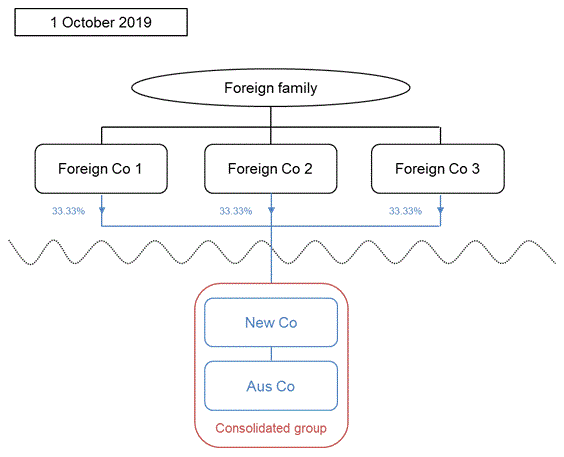
29. The conditions in subsection 716-440(1) are satisfied in this example. That is:
- •
- paragraph 716-440(1)(a) is satisfied as Aus Co became a subsidiary of a consolidated group (the New Co consolidated group) at the joining time
- •
- paragraph 716-440(1)(b) is satisfied as Foreign Co 1, Foreign Co 2 and Foreign Co 3 all ceased to hold membership interests in Aus Co during the period starting 12 months before the joining time and ending immediately after the joining time (the 'test period')
- •
- paragraphs 716-440(1)(c) and (d) are satisfied as CGT event A1 happened as a result of Foreign Co 1, Foreign Co 2 and Foreign Co 3 ceasing to hold membership interests in Aus Co and the resulting capital gain was disregarded under Division 855
- •
- paragraph 716-440(1)(e) is satisfied because, if the churning measure did not apply, the entry tax cost setting rules would have applied to reset the tax cost of Aus Co's assets at the joining time
- •
- paragraph 716-440(1)(f) is satisfied as, throughout the test period, the total participation interests held by each of the control entities and their associates in Aus Co remained the same, taking into account the following factors:
- -
- Foreign Co 1, Foreign Co 2 and Foreign Co 3 are associates of each other because they are collectively controlled by the same foreign family
- -
- from 1 September 2017 to just before the joining time, 100% of the total participation interests in Aus Co were jointly held by Foreign Co 1, Foreign Co 2 and Foreign Co 3
- -
- immediately after the joining time, the sum of the indirect participation interests (held through New Co), and therefore the sum of the total participation interests held by Foreign Co 1, Foreign Co 2 and Foreign Co 3 in Aus Co was 100%
- -
- at all relevant times each of Foreign Co 1, Foreign Co 2 and Foreign Co 3 is a control entity and a disposing entity because at those times the sum of the total participation interests held by each of those entities and their associates was 100% (disregarding any particular direct participation interest or particular indirect participation interest that could be taken into account more than once)
- •
- paragraph 716-440(1)(g) is not relevant because each of Foreign Co 1, Foreign Co 2 and Foreign Co 3 is a control entity and a disposing entity.
Relief for post-acquisition restructures within 12 months
30. Under paragraph 716-440(1)(f), it must be reasonable to conclude that the control entity and its associates held (collectively) total participation interests of 50% or more in the joining entity throughout the test period.[18] The test period is the period that started 12 months before the joining time and ended immediately after the joining time.[19]
31. As explained in Board of Taxation 2012, Post implementation review into certain aspects of the consolidation regime, section 716-440 is intended to allow a foreign group to restructure its holding of an Australian entity within a 12 month period after the group acquires the entity. In other words, the tax costs of the assets of a joining entity that has been recently acquired (that is, within 12 months) by a control entity can continue to be reset where the joining entity is transferred into a consolidated group owned by the same control entity.
32. There may be circumstances where a foreign resident restructures its holding of an Australian entity (that is, the churning entity) within a 12 month period of acquiring that entity and, although the underlying assets of the churning entity have been majority owned by the same control entity and its associates (via participation interests in other entities that owned the assets) for more than 12 months, the relevant requirements of paragraph 716-440(1)(f) are not satisfied (and therefore the churning measure would not apply). In those circumstances the application of Part IVA would be carefully considered if the restructure is not motivated by dominant commercial reasons but is entered into for the dominant purpose of enabling the relevant taxpayer to obtain a tax benefit. Where Part IVA applies to such restructure, the Commissioner may make a determination, under section 177F of the ITAA 1936, to cancel any tax benefit obtained in connection with it.
Commissioner of Taxation
9 May 2018
Your comments
33. You are invited to comment on this Guideline including the proposed date of effect. Please forward your comments to the contact officer by the due date.
34. A compendium of comments is prepared for the consideration of the relevant Public Advice and Guidance Panel or relevant tax officers. An edited version (names and identifying information removed) of the compendium of comments will also be prepared to:
- •
- provide responses to persons providing comments
- •
- be published on the ATO website at www.ato.gov.au.
Please advise if you do not want your comments included in the edited version of the compendium.
| Due date: | 8 June 2018 |
| Contact officer details have been removed following publication of the final ruling | |
© AUSTRALIAN TAXATION OFFICE FOR THE COMMONWEALTH OF AUSTRALIA
You are free to copy, adapt, modify, transmit and distribute this material as you wish (but not in any way that suggests the ATO or the Commonwealth endorses you or any of your services or products).
Footnotes
This measure reflects recommendation 5.6 of the Board of Taxation Post implementation review into certain aspects of the consolidation regime, June 2012 report.
Section 716-440 is being inserted by the Treasury Laws Amendment (Income Tax Consolidation Integrity) Act 2018.
For example, where a consolidated group is acquired by another consolidated group or multiple entities linked by membership interests are acquired by a consolidated group.
Where the amount of the capital gain or capital loss is nil, the churning measure would still apply if Division 855 would have applied to disregard an amount if there had been a capital gain or loss (subparagraph 716-440(1)(d)(ii)).
The date on which Treasury Laws Amendment (Income Tax Consolidation Integrity) Bill 2018 (which became this Act) was introduced into the House of Representatives.
By operation of section 719-2, section 716-440 applies to a MEC group in the same way it applies to a consolidated group.
Paragraph 716-440(1)(b), as modified by subsection 716-440(5) where relevant.
Paragraph 716-440(4)(a).
Paragraph 716-440(4)(b).
It is noted that there is an obvious drafting error in paragraph 716-440(1)(e), which refers to subsection 716-440(2). It should be read as if it instead referred to subsection 716-440(3).
Paragraph 716-440(4)(a).
Paragraph 716-440(4)(b).
In this context, an 'entity' takes its meaning from section 960-100.
Subparagraph 318(2)(d)(i) of the ITAA 1936.
Subparagraph 318(2)(d)(ii) of the ITAA 1936.
Subparagraph 318(2)(e)(i) of the ITAA 1936.
Subparagraph 318(2)(e)(ii) of the ITAA 1936.
Subsection 716-440(2) ensures that a particular direct participation interest or a particular indirect participation interest is not counted more than once.
Paragraph 716-440(1)(b).
References
File 1-AOP7K8L
Business Line: PGI
Legislative References:
ITAA 1936
ITAA 1936 177F
ITAA 1936 318
ITAA 1936 318(2)(d)(i)
ITAA 1936 318(2)(d)(ii)
ITAA 1936 318(2)(e)(i)
ITAA 1936 318(2)(e)(ii)
ITAA 1936 Pt IVA
ITAA 1997
ITAA 1997 716-440
ITAA 1997 716-440(1)
ITAA 1997 716-440(1)(a)
ITAA 1997 716-440(1)(b)
ITAA 1997 716-440(1)(c)
ITAA 1997 716-440(1)(d)
ITAA 1997 716-440(1)(d)(ii)
ITAA 1997 716-440(1)(e)
ITAA 1997 716-440(1)(f)
ITAA 1997 716-440(1)(g)
ITAA 1997 716-440(2)
ITAA 1997 716-440(3)
ITAA 1997 716-440(4)
ITAA 1997 716-440(5)
ITAA 1997 719-2
ITAA 1997 Div 855
ITAA 1997 960-100
Treasury Laws Amendment (Income Tax Consolidation Integrity) Act 2018
Other References:
Explanatory Memorandum to the Treasury Laws Amendment (Income Tax Consolidation Integrity) Bill 2018
Board of Taxation Report on the Post implementation review into certain aspects of the consolidation regime, June 2012
Board of Taxation Position Paper on the Post implementation review into certain aspects of the consolidation regime, October 2010
